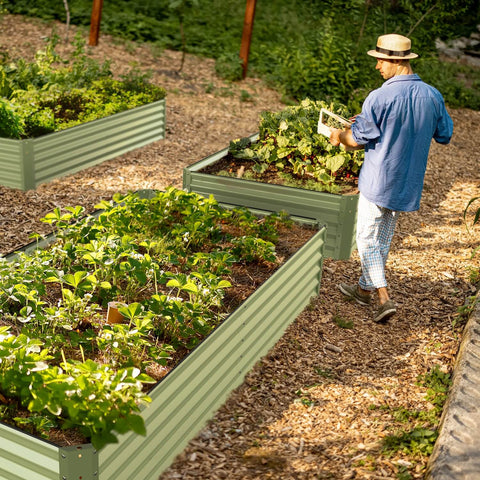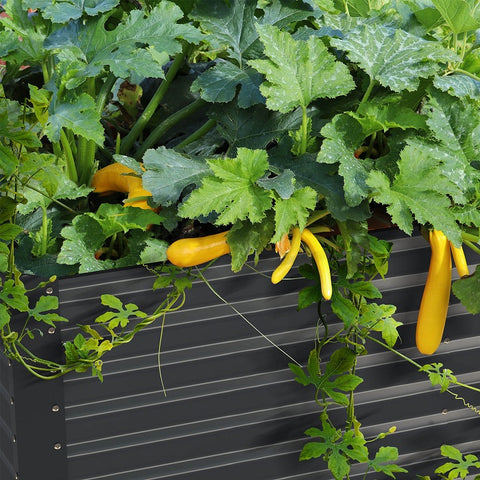You have an idle yard, want to create a garden, feel unable to plan, do not know how to start, want to transform into a vegetable garden, but feel not beautiful, you can consider a garden bed, it can make your garden and vegetable field perfect combination, both ornamental and practical! Everyone of us likes planting. But as a beginner, it's hard to choose what I should plant first. Because of this, this article will guide beginners to growing 10 simple plants quickly at home.The following content also has some reference value for raised garden beds.
The main introduction of this article includes,
- Planting introduction
- The 10 easiest plants to grow
- 5 simple plant growing FAQs
- 18 Great tips for growing plants
Let's get started.
Planting profile
Growing up, gardens provide more than just delicious, nutritious food. Growing plants is good for your overall health, whether it's eating them or appreciating their beauty. Working with plants improves physical health because it's a great form of exercise, and it shows that spending time with nature reduces stress.

If you want to get your hands dirty and start growing your food, check out these ten plants that don't require a gardening expert.
Live plants are a great way to liven up any room, from your office to the bathroom, quickly and cheaply. Contrary to popular belief, there are quite a few houseplants that are easy to grow, even for those who don't consider themselves green-fingers.
The 10 easiest plants to grow
- Pansies
These flowers are hard to kill - pansies are strong enough to withstand winter temperatures in much of the United States. Over 200 species of pansy, including a few, are bred primarily for very hot or very cold conditions.
The best time to plant pansy is when the soil temperature is about 50° to 60°F(August in the south, and October in the northern regions), but you can also plant in early spring. You can buy mature plants at most garden stores and plant them directly in the ground if you plan to sow them in 7 to 12 inches of moist soil.
Pansy grows well in direct sunlight in cooler climates. If you live in a warm area, give the flowers some shade, plant them strategically so they can spend three to five hours a day in the shade, and make sure they get an inch of water a day.
- Bush bean
Bush beans are by far the most common bean for home gardeners. They grow on compact, dense plants, so there is no need for stakes, poles or trellises.
Just plant, and you'll have a delicious crop in seven to eight weeks. Plant a bush bean every two weeks and you'll have fresh beans on your table all summer long, enough to freeze, or winter as well.
Step 3: Spinach
Spinach grows quickly, making it a perfect crop for first-time gardeners. This fast-growing plant produces a few leaves during warm weather such as early spring and early fall.
In warm climates, it can tolerate cold temperatures, even below freezing, and can overwinter. You'll know it's a choice when it looks big enough to eat!

- Basil
Basil and tomatoes make a great combination for pasta sauces, and these two plants can help each other in the garden. According to amateur and experienced gardeners, basil is a natural insect repellent that will keep away unwanted insects that would otherwise eat the herb, or chew your tomato fruit.
Some also believe that planting the two together in some way will make the tomatoes taste better. Basil grown in the garden needs plenty of sunlight and should be arranged accordingly. Seeds should be planted at least 12 inches away six weeks before the last frost. If the soil feels dry, water lightly and you have a safe plant that will provide you with delicious leaves all summer long.
- Sunflower
If you crave their seeds, or want to see them, sunflowers are perfect for gardeners from the start. They don't need much when it comes to fertilisation, they can survive in all but the wettest soil, and they are particularly good at resisting drought.
These flowers really do need clear, unimpeded sunlight, as their name suggests. Place your sunflowers outdoors, making sure they are far away from other plants you might grow, as a row of tall sunflowers will cover neighboring vegetables with excess mulch.
Wait until the last frost of spring has passed before you start planting, then plant the seed in a 1-inch hole. For better results, place them at least 6 inches away - preferably 24 inches if you're dealing with larger species.
- Radishes
An ideal cool-weather crop, turnips grow pungent bulbs during the colder months of spring and fall. Place the seeds in soft, moist, well-lit soil about half an inch wide, at least an inch apart.
They grow quickly: some radishes are ready to be harvested after 22 days of planting, but up to 70 other varieties may be needed if your radishes start to grow leaves; Pull the radish every other time, cut the radish wire fine.
A new row of vegetables can be planted in early spring or late summer, depending on when you decide to dig up the vegetables to eat; If your turnips start to grow leaves, pull them out every other root and cut the twine thin. A new row of vegetables can be planted in early spring or late summer, depending on when you decide to dig up the vegetables to eat.
- Calendula
As for growing flowers, marigolds are certainly in the foolproof category. Please wait until the spring frost is over before sowing. Almost any type of bedding will suit them, although moist, well-drained soil is preferable.
Marigold lovers often obtain their source by purchasing marigolds in bags; These have unique spacing indicators and other themes. Cover all the seeds with a small amount of soil, not allowing the soil to become too dry, and remove some of the seedlings. As long as you hold out until football season, you'll get colorful flowers.
- Zucchini
Not only are zucchini super easy to grow, but they're also incredibly productive. Your garden can produce enough plants to feed a small army in a few weeks. Sometime between early spring and mid-summer, dig a row of inch-deep holes in the ground (although realistically, a plant or two might be enough).
There should be a distance between the depressions, about three feet; Each pit contains two or three seeds. Make sure the dirt is warm and always moist (regular mulching will help you do this).
You can start harvesting in six to eight weeks. Since new zucchini are sprouting to replace the uprooted pumpkin, you'll soon have quite a harvest. A single plant can produce a value of £10 a season.
- Green vegetables
You can grow mixed vegetables almost anywhere, even on windowsills. Lettuce is a cool climate crop that can be grown in both spring and fall. It doesn't matter to the crowd, so grab a jar and scatter these seeds generously.
When some of the leaves are large enough to eat, thin them down and continue to cut off as many leaves as needed until the stems of the plant have grown. If you're ambitious, save it for next summer.

- Brussels sprouts
Broccoli bunnies are another seasonal, simple vegetable that deserves a place in your garden. Novice gardeners just need to be mindful of arranging flowers quickly, so harvest them as soon as you see the buds appear, cutting about five inches below them.
New shoots will grow near the rest of the stem and can also be harvested. Plant in early spring and early fall and have fun.
18 Amazing tricks to Make plants Grow Easier
5 Simple plant growing FAQs
- Do plants like to be touched?
Obviously, your plants hate it when you're near them.
A recent study conducted by the La Trobe Institute for Agriculture and Food Research found that most plants are susceptible to contact, and even mild contact can severely stunt their growth, Phys.org reported.
- What time of day do plants grow the most?
Most plants grow more at night and in the evening.
Although plants absorb energy during the day, synthesis of new tissue is usually done at night, when conditions allow for heat stress and water loss.
- What is the best way to control weeds?
Prepare the bed before planting by laying a 3-inch layer of straw around the plant. Every now and then, you always need to weed.
- What vegetables can I grow in the shade?
Most vegetables don't grow well in complete shade, but few tolerate shade better than others. Lettuce and peas also grow well in partial shade during the summer.
- What is different or unique about plants?
Land plants are multicellular species with several characteristics that distinguish them from other living things: they produce food;
Plants photosynthesize and contain chlorophyll, a green pigment that allows plants to convert the sun's energy into food.
Conclusion - Easy to grow plants
Houseplants can be grown easily for the first time or any time as long as you choose plants that are easy to grow. Once you get good at it, try some challenging plants to keep growing. Take good care of them and start another strong plant. Keep it up until you can keep every single plant alive and well.
Have a nice day!









